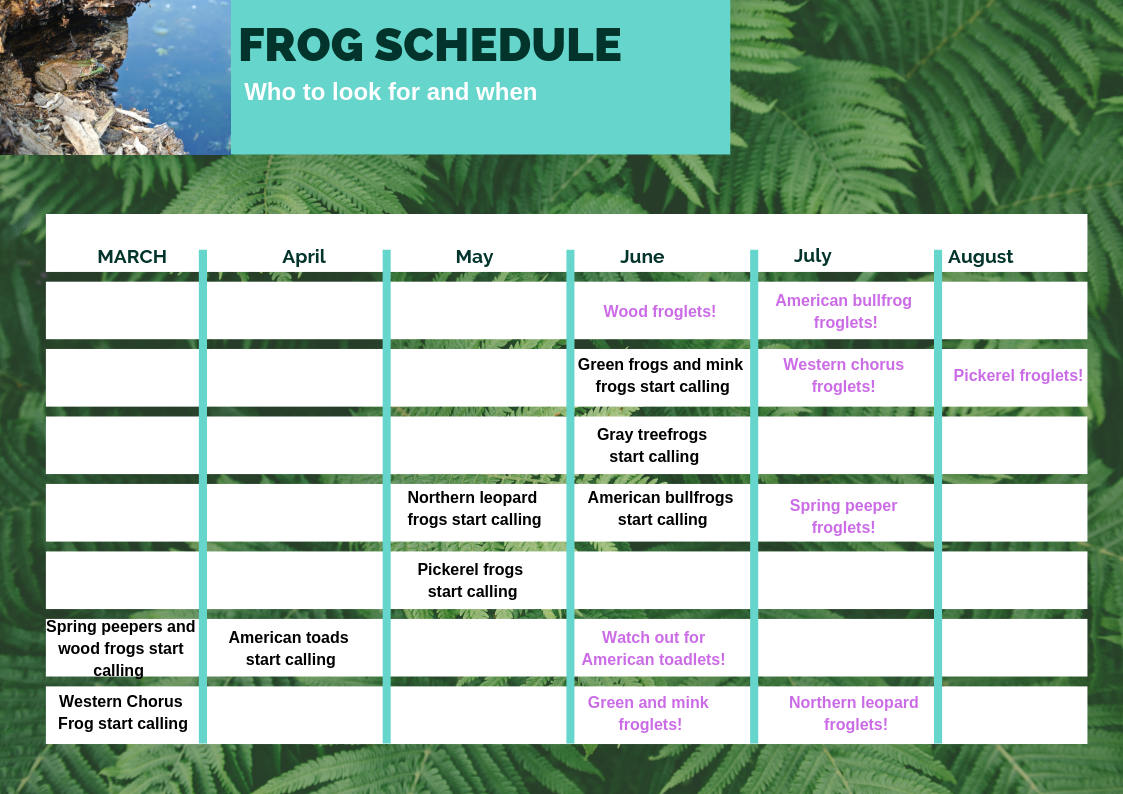Frogs and Toads
When thinking about the early signs of springs you might think about American robins, red-winged blackbirds, daffodils or crocuses - but let’s not forget about our amphibian friends! Several species of frogs start their mating calls as early as March - well before many migratory birds have arrived or flowers start poking through the barely thawed soil.
If you’re ready to take advantage of the lovely spring weather, “frogging” is a great place to start. If you aren’t sure where to begin, don’t worry - there are lots of online resources that will provide you with identification guides, what to look for, when to look, and how to do it! Two great resources, which also have strong citizen science components, are Ontario Nature and FrogWatch. Through citizen science data submitted by folks like you, both are able to track things like geographic range and time of year different frogs and toads are observed.
Whether you’re new to frogging or have been doing it for years, Ontario Nature’s frog and toad ID quizzes are a great way to challenge yourself. Check out the Ontario Nature Reptile and Amphibian Atlas landing page for the quizzes and more.
Interactive range map of the Northern leopard frog from Ontario Nature
Tracking the presence or absence of frogs in a particular area over many years provides really important information to researchers, since frogs and toads are another group of animals that are considered good environmental indicators. Take a look at the figure below -- there are lots of areas in red, which represents sightings from before 1999. Clicking on each individual square will pull up information about all the sightings in that area. Information like this can help scientists think about and answer questions about that area and why frogs are no longer being reported there. The answer to those kinds of questions can have implications for how that land is managed in the future, and how other places can be managed to avoid the loss of amphibians. So why are frogs and toads good indicators of the health of the environment? I think FrogWatch says it best on their website:
Check out the infographic and calendar for some more cool facts about frogs and toads, and to learn good times of years to see the different species. Click to Expand it!
“Perhaps because they live ‘on the edge’ between water and land, and have semi-permeable skin, frogs and toads are very sensitive to pollution and other environmental changes… Frogs and toads can be used as indicator species, because they are vulnerable to changes in the atmosphere, the land, or the water. Tracking changes in the geographic range, the beginning and ending of the calling season, and the population of frogs and toads in Canada can help us understand changes occurring in the environment.”
—FrogWatch 2019
EcoSpark would love to facilitate an amphibian inquiry with your class - sign up for School Watch to learn how to lead citizen science projects on and around your school property, and for the option to have EcoSpark staff come out to help you and your students observe and record frogs and toads.
Sara's passion for ecology, bird watching, and educating the public about the environment started during her undergraduate degree, where she focused on biodiversity, conservation, and ecology. Through a graduate degree in Environmental Science, Sara discovered the immense value of citizen science for advancing conservation, and has been working professionally and on a volunteer basis to encourage the public to take an active role in protecting their local environment and beyond. Working with EcoSpark was the logical way forward as Sara continues with her passion of spreading knowledge about nature and how fun and amazing it can be!



